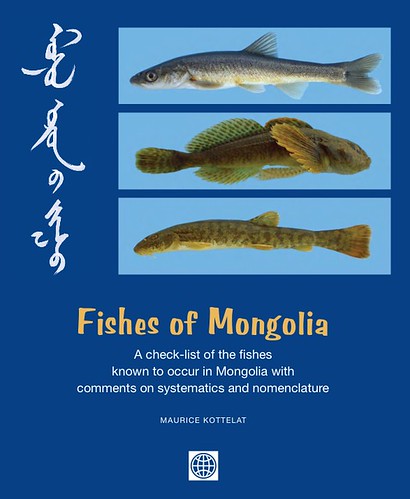A check-list of the fishes known to occur in Mongolia with comments on
systematics and nomenclature. M. Kottelat. September 2006. 103 pp, 2
appendices. Environment and Social Development Unit, East Asia and
Pacific region, The World Bank.
Available for download from: worldbank.org.

This report is the second systematic work to be published by Environment and Social Development Unit of the World Bank. It is based on work done in 2005 and was partly funded by the World Bank’s Netherlands-Mongolia Trust Fund for Environmental Reform (NEMO). It is mainly based on existing literature, interviews, preserved material and very limited field collections.
A total of 76 native species from 14 families are recorded, with possibly five new taxa and another six introduced species, in Mongolia. A list of 81 invalid names is also given to highlight the complex and unstable situation with the taxonomy of Mongolian fishes. The systematics and nomenclature of the fishes are re-evaluated and brought up to date. This list is also compared with fish of neighbouring countries, namely the Chinese Provinces of Xinjiang and Nei Mongol, and the Russian Tuva and Buryatia Republics. The evaluation of this present report is that the fish diversity in Mongolia is far from adequate and the number of fish species is underestimated.
From this present report, it is also apparent that there are a large number of nomenclatural inconsistencies across the political boundaries. These problems stem from different conceptual approaches to taxonomy, lack of communication and the ignorance of the International Code of Zoological
Nomenclature (ICZN).
It includes a section with detailed accounts of the fishes of Mongolia, including original citations and subsequent synonymies. Each account starts with an introduction to the family, followed by the species account, with synonymy, remarks on systematics and distribution. A small section on accounts of species recorded from adjacent areas is also included.
This is followed by a recommendation section which lists the priority areas to be surveyed, taxonomy of selected fish groups to be revised along with fresh field collections, with comparative studies of related fauna from China and Russia.
A long bibliography list concludes the report.
At the end of the report, two appendices and one addendum is attached. The first appendix deals with nomenclatural data on species mentioned in the text but not located from Mongolia. The second appendix illustrates the fishes with colour plates of living and freshly preserved specimens, interspaced with black and white plates. The addendum lists more records obtained that were too late to include in the main text.
All in all, this is a small and concise publication, done up to high standards expected from any of Maurice Kottelat’s endeavours. This is a very commendable effort and an important piece of work for ichthyologists working on the freshwater fishes of Asia.
Tan Heok Hui
Department of Biological Sciences,
National University of Singapore,
Kent Ridge 119260, Republic of Singapore
First published in The Raffles Bulletin of Zoology Vol. 55(1): 221 on 28 Feb 2007.

1 comment:
To me, this piece of work shows that the number of experts working in the field of biology and taxonomy is too little such that existing literature/research is outdated, which makes current work on fishes of Mongolia more difficult. As can be seen from the executive summary, there were a large number of nomenclature inconsistencies.
I think the reason for the few people in the field of taxonomy is due to the disinterest in taxonomy, which is due to the conception by most people that taxonomy is boring and useless. This therefore leads to a lack in funding for research and fieldwork, which contributes to an unwillingness in entering that field.
Work should be done to encourage more people to enter the field of taxonomy, yet it is not easy due to little support given by the government (private companies are usually driven by profit and thus unlikely to contribute to biodiversity research) Right now the political events happening in our world (oil crisis, war, envt problems) is such that few countries have the money and time to encourage biodiversity research.
Therefore, work on the fishes of Mongolia is all the more rare and important, as it serves to bring our current knowledge on biodiversity up-to-date, albeit it being a small contribution.
Post a Comment